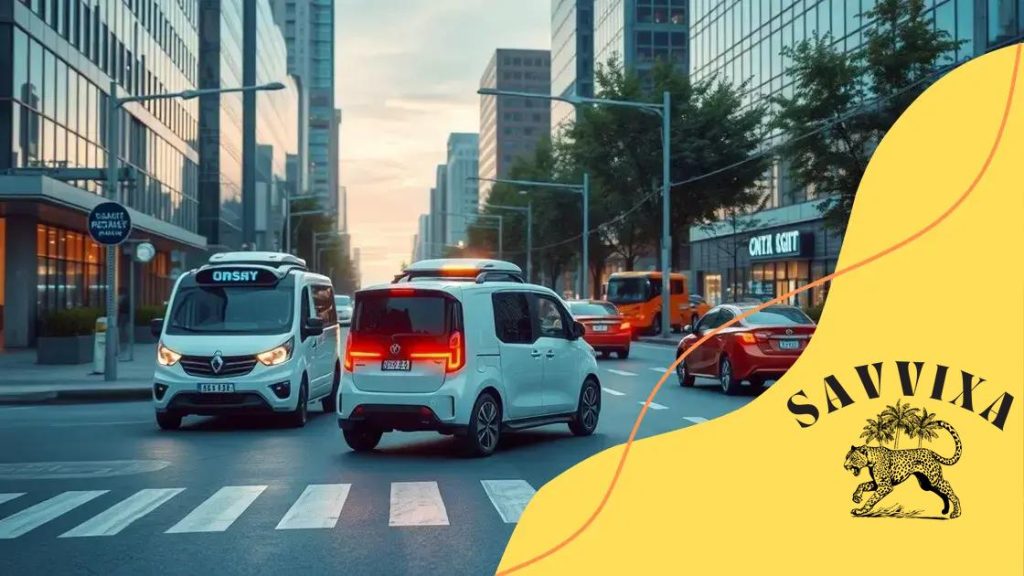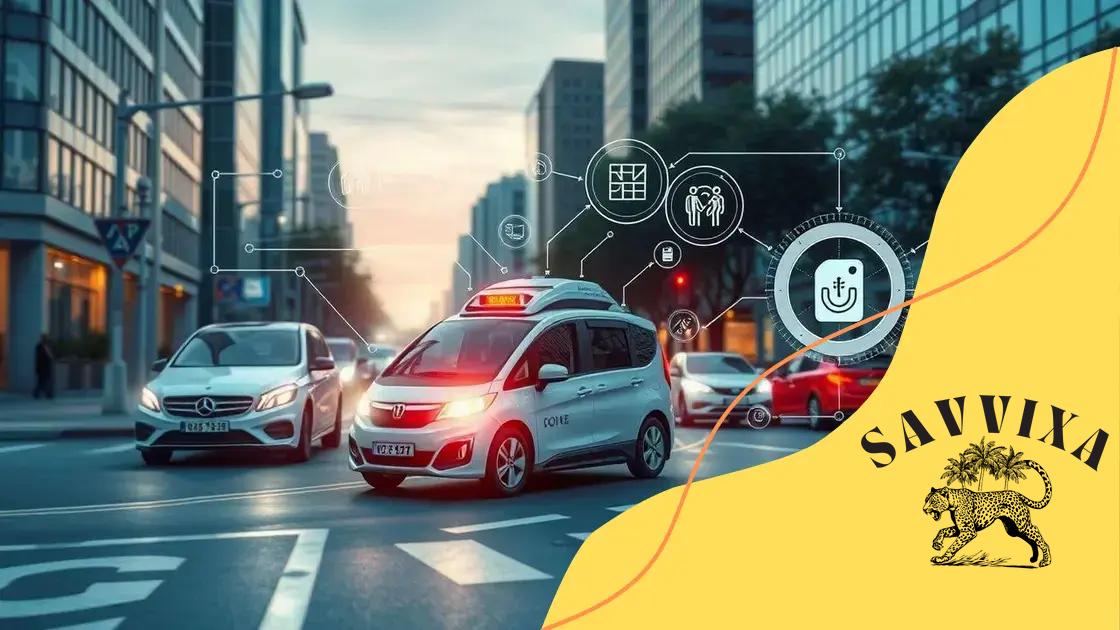The future of automated transportation systems is here

The future of automated transportation systems includes advancements in technology, enhanced safety, sustainability, and accessibility, while facing challenges like regulatory hurdles and public acceptance.
The future of automated transportation systems is shaping the way we think about travel. Have you ever imagined a world where vehicles communicate with each other? Let’s explore the innovations that make this possible.
Understanding automated transportation systems
Understanding automated transportation systems is crucial as technology advances. These systems aim to improve safety and efficiency in our travel. Innovations like self-driving cars and drones are changing how we move from one place to another.
Automated vehicles use sensors and algorithms to navigate. They rely on data to make real-time decisions, reducing the risk of accidents caused by human error. Public transportation is also evolving. Systems like buses and trains are becoming more integrated with automation, enhancing the user experience.
Key Components of Automated Systems
Understanding the elements of these systems can help us appreciate their impact:
- Artificial Intelligence: The brain behind automation, AI processes vast amounts of data.
- Sensors: These devices detect obstacles, allowing vehicles to respond quickly.
- Communication: Vehicles communicate with each other and infrastructure, improving safety.
- Software: Algorithms control vehicle behavior, ensuring smooth operations.
As we explore the landscape, it’s important to consider how automated systems can address urban challenges. Traffic congestion and pollution are major issues in cities worldwide. Automated transportation can reduce the number of cars on the road and enhance public transit efficiency.
Moreover, the social implications are significant. Access to transportation can improve mobility for those who cannot drive. As automated systems develop, they may offer solutions for underserved communities.
Regulatory Considerations
With innovation comes the need for regulations. Governments must establish guidelines to ensure safety and reliability. As public trust builds, more people will embrace automated options.
Education on how these systems work can foster acceptance. By promoting awareness, we can prepare society for a future where automated transportation is the norm.
Benefits of automated transportation for society
Benefits of automated transportation for society are vast and impactful. As cities grow and populations increase, the need for efficient transport solutions is more important than ever. Automated systems are designed to address these challenges, making travel safer and more accessible.
One of the significant advantages of automation is its ability to enhance road safety. With advanced technologies, automated vehicles can reduce human error, which is a leading cause of accidents. They can react faster to obstacles and make informed decisions based on real-time data.
Environmental Advantages
Automated transportation systems also contribute to a cleaner environment. Reduced congestion leads to decreased emissions, which helps combat climate change. Furthermore, with fewer vehicles on the road, urban areas can experience less pollution. This can significantly improve public health as air quality enhances.
- Lower emissions: Automated vehicles can drive more efficiently, reducing fuel consumption.
- Carpooling: Systems can facilitate ride-sharing, decreasing the number of cars needed.
- Smart traffic management: Enhanced systems reduce traffic jams, leading to less idling.
Moreover, automated transportation provides greater accessibility for everyone. This is especially valuable for people with disabilities, the elderly, and those without a driver’s license. With improved access, individuals can reach essential services and engage more with their communities.
Innovation in transportation can lead to economic growth. When people can move around more effectively, businesses benefit from increased productivity. New job opportunities in automated sectors can also arise as technology continues to advance.
Social Impact
The social acceptance of automated systems is vital. As we witness their benefits, public perception can shift positively. Education about automation is crucial to ensure people understand the advantages these systems bring. Communities that embrace change often see greater improvements in their quality of life.
Key technologies driving automation

Key technologies driving automation are transforming how we approach transportation. These innovations are not just ideas; they are shaping our daily lives and making travel safer and more efficient. Understanding these technologies is essential to grasp the future of transportation systems.
One critical component is artificial intelligence. AI enables vehicles to think and learn, processing vast amounts of data to make quick decisions. For instance, self-driving cars use AI to analyze their surroundings and navigate complex environments.
Sensor Technology
Another vital technology is sensor technology. Sensors are the eyes and ears of automated vehicles. They provide information about the vehicle’s environment, detecting obstacles, traffic signals, and lane markings. This data is crucial for safe navigation.
- Lidar: Uses laser light to create detailed maps of the surroundings.
- Radar: Helps detect the distance and speed of objects nearby.
- Cameras: Provide visual recognition for identifying road signs and pedestrians.
- GPS: Offers real-time location tracking and navigation assistance.
Connectivity is another essential aspect. Vehicles today are increasingly connected to the internet and each other. This communication enhances safety and efficiency. For instance, vehicles can share data about road conditions and traffic patterns, helping to prevent accidents.
Moreover, machine learning plays a significant role in improving automated systems. This technology allows vehicles to adapt and improve over time, learning from past experiences and user behaviors. As a result, automated systems can provide a better and more personalized experience for users.
Software Development
Finally, the development of sophisticated software is vital for automation. Robust software controls vehicle functions and coordinates the integration of various technologies. As software continues to evolve, we can expect more reliable and safer automated systems.
Challenges facing automated transportation
Challenges facing automated transportation are significant as technology progresses. While the benefits are clear, several hurdles must be overcome to realize fully automated systems. These challenges range from technical issues to social acceptance.
One major obstacle is technical reliability. Automated vehicles must perform safely under various conditions. For example, harsh weather can impair sensors, leading to potential accidents. Developers are working hard to ensure systems are robust and can adapt to changing environments.
Regulatory Hurdles
An essential challenge stems from regulatory frameworks. Governments need to create clear guidelines for the operation of automated vehicles. Current laws may not address the unique aspects of automation, which can slow down deployment. Collaboration between tech companies and lawmakers is crucial for effective regulations.
- Safety standards: New safety measures must be developed for automated systems.
- Liability issues: Determining who is responsible in accidents involving automated vehicles remains complicated.
- Insurance frameworks: Traditional insurance models may need to adapt to cover automated driving.
- Data privacy: Protection of personal data collected by automated systems is a growing concern.
Public acceptance poses yet another challenge. Many people are still wary of automated transportation due to fears about safety and losing control. Educating the public about the benefits and safety measures of these technologies is vital in gaining trust.
Moreover, ethical concerns also arise. Questions about decision-making in critical situations need to be addressed. For instance, how should an automated vehicle react in an unavoidable accident? These ethical dilemmas must be part of the conversation around automation.
Infrastructure Limitations
Finally, existing infrastructure may not be ready for automated systems. Roads, traffic signals, and signage often need upgrades to support automated technologies. Investments are required to develop smart infrastructure that can communicate with vehicles and improve safety.
The future landscape of transportation systems
The future landscape of transportation systems is set to evolve significantly. As technology progresses, we can expect major changes in how we travel. The integration of automated systems will create a more efficient and connected world.
One exciting development is the rise of smart cities. These cities will use technology to optimize transportation. By integrating data from various sources, urban planners can create efficient traffic management systems. This means less congestion and shorter travel times for everyone.
Enhanced Public Transport
Automated public transportation options will play a vital role in the future landscape. Self-driving buses and shuttles can provide on-demand services, reducing waiting times and increasing convenience. These systems can operate with greater frequency and efficiency, improving accessibility for residents.
- Reduced travel costs: Public transport will become more affordable as automation cuts operational expenses.
- Increased reliability: Automated systems can provide more consistent schedules, boosting user confidence.
- Improved safety: With advanced sensors and AI, public transport can enhance user safety.
Moreover, we will increasingly see integration between different modes of transportation. For instance, individuals may seamlessly switch from a self-driving car to a bike-sharing service. This encourages a more sustainable approach to travel.
The use of electric vehicles will also dominate the future landscape. With a focus on environmental sustainability, many automated vehicles will be electric, reducing emissions significantly. This shift will contribute to cleaner air and better health outcomes for residents.
Impact of Technology on Mobility
Additionally, technologies like blockchain may help create secure and efficient payment systems for transportation. Passengers could pay for their journeys in a simple, user-friendly manner. This technology can also enhance the tracking of vehicles and cargo, ensuring timely deliveries.
Finally, the future will bring about enhanced mobility for everyone. Automated systems can provide services to those who currently face challenges, such as the elderly and disabled. By improving accessibility, we create a more inclusive society where everyone can participate.
In conclusion, the future of automated transportation systems promises exciting advancements that will reshape how we move. With key technologies driving innovation, we can expect safer, more efficient, and inclusive travel experiences. As we overcome challenges and build smarter cities, accessibility and sustainability will become essential parts of our daily lives. Embracing these changes will lead to a brighter future for transportation, benefiting society as a whole.
FAQ – Frequently Asked Questions About Automated Transportation Systems
What are automated transportation systems?
Automated transportation systems include vehicles and services that operate without human intervention, using technologies like AI and sensors to navigate safely.
How do automated systems improve road safety?
These systems reduce human error—one of the leading causes of accidents—by utilizing advanced sensors and real-time data to make quick decisions on the road.
What role do smart cities play in automated transportation?
Smart cities integrate technology to optimize traffic management and enhance public transport systems, making full use of automated transportation solutions.
What challenges do automated transportation systems face?
Challenges include technical reliability, regulatory hurdles, public acceptance, and the need for upgraded infrastructure to support these technologies.